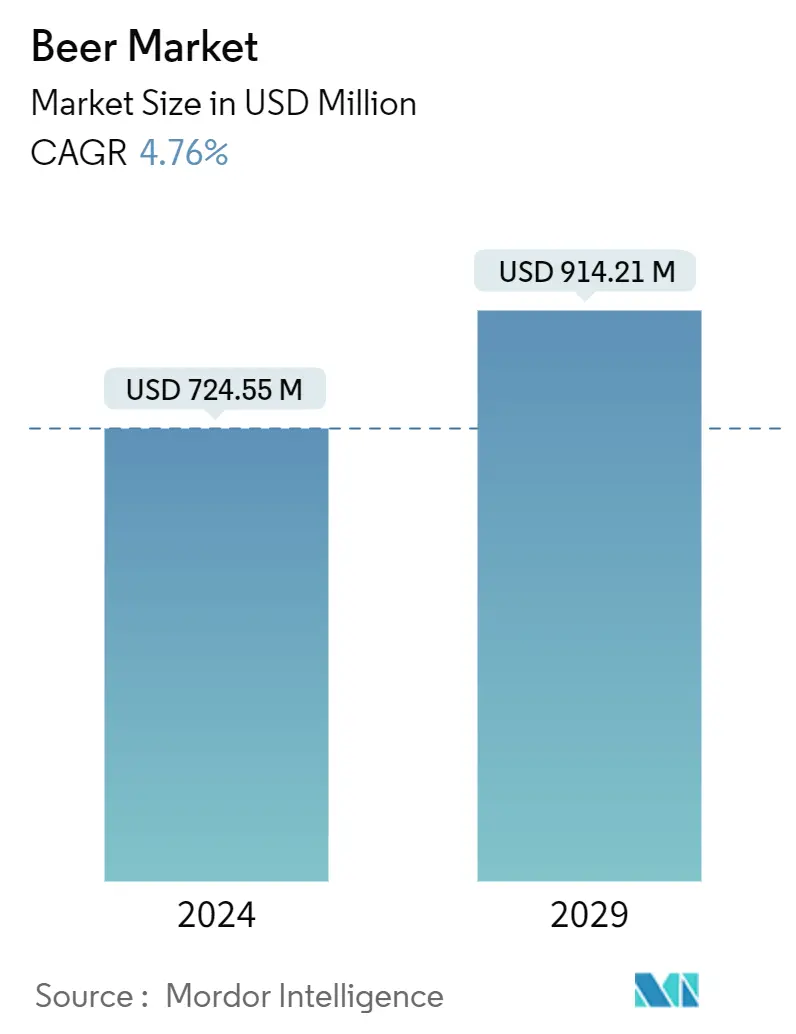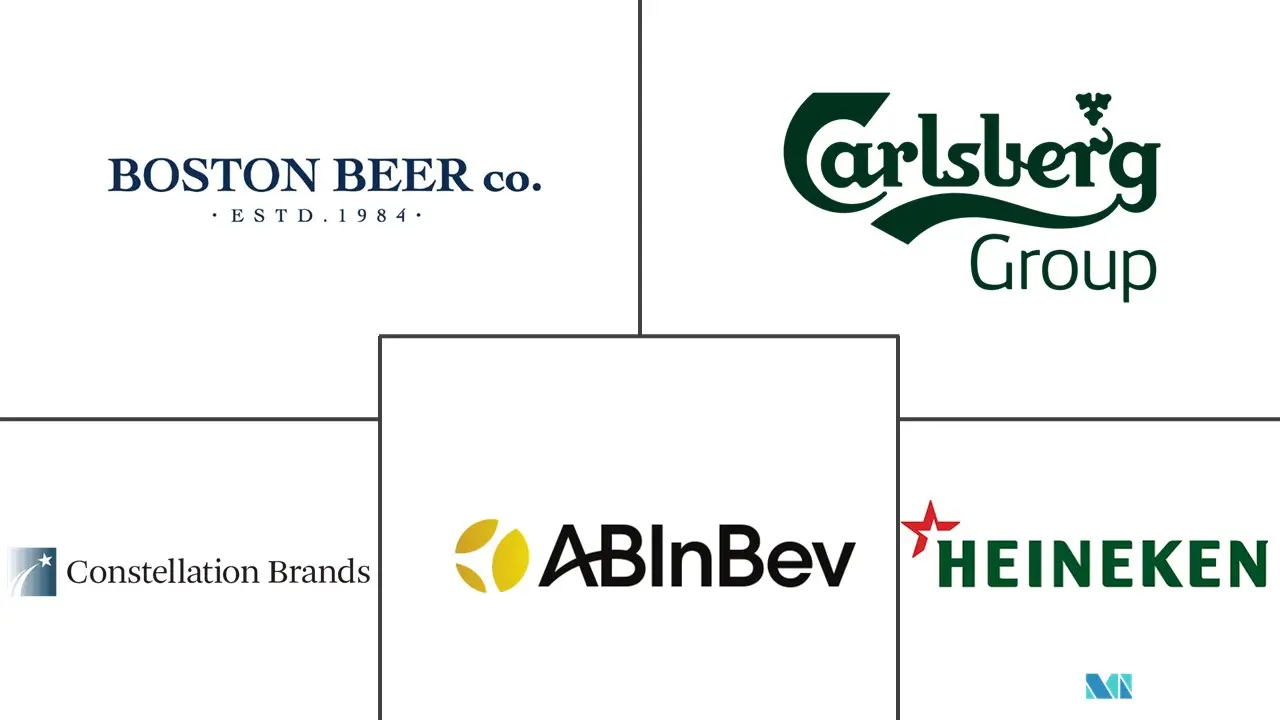Market Size of Beer Industry

| Study Period | 2019 - 2029 |
| Market Size (2024) | USD 724.55 Million |
| Market Size (2029) | USD 914.21 Million |
| CAGR (2024 - 2029) | 4.76 % |
| Fastest Growing Market | Asia Pacific |
| Largest Market | North America |
Major Players
*Disclaimer: Major Players sorted in no particular order |
Beer Market Analysis
The Beer Market size is estimated at USD 724.55 million in 2024, and is expected to reach USD 914.21 million by 2029, growing at a CAGR of 4.76% during the forecast period (2024-2029).
- Beer holds a prominent share in the market for alcoholic beverages. Beer already has significant popularity among millennials and Gen Z due to its diverse formulations and flavor offerings. Over the medium term, changing lifestyles, the increasing consumption rate of alcoholic drinks, rapid urbanization, and high disposable incomes are expected to support the global beer market. Additionally, introducing new ingredients combining fruity and tart flavors in craft beers has increased its appeal among millennials.
- The wide availability of beer brands and products in the market and the continued strength of well-positioned beer companies have been significant positive factors for the beer industry. For instance, as one of the fastest-growing brands in the world, Bira 91 has built a diverse portfolio of beers, one for every occasion, and aims to drive the global shift in beer toward more color and flavor. With such strategies, the brand is focused on offering its products for every occasion to expand its sales.
- Consequently, consumers' inclination toward low alcohol, by volume, has significantly driven the beer market share. The increased health awareness among people and the promoted inclusion of functional and natural ingredients provides more significant opportunities for the premium beer market, leaving beer companies with new opportunities to cater. Therefore, seeking massive potential in the premium category, the leading players operating in the global beer market are tapping into the category.
- For instance, In September 2022, United Breweries Ltd., a part of Amsterdam-based Heineken Group, launched Heineken Silver to expand its portfolio in the premium beer category in India. Natural ingredients such as A-yeast and pure malt are used in brewing Heineken Silver by seasoned master brewers. Such developments, coupled with increasing consumption and inclination towards sophisticated beer options, are expected to support and drive the market growth during the forecast period.
Beer Industry Segmentation
Beer is an alcoholic drink made from yeast-fermented malt and flavored with hops. The beer market is segmented by type, category, distribution channel, and geography.
The global beer market share is segmented based on type into lager, ale, and other product types. The market is segmented into standard and premium beer based on categories and beer market share by brand is also provided. The distribution channel segment of the beer market includes on-trade and off-trade channels. The market is segmented by geography into North America, Europe, Asia-Pacific, South America, and the Middle East and Africa.
For each segment, the beer market size and forecasts have been done based on the value in USD.
| By Product Type | |
| Lager | |
| Ale | |
| Other Product Types |
| By Category | |
| Standard Beer | |
| Premium Beer |
| By Distribution Channel | |
| On-trade Channels | |
| Off-trade Channels |
| By Geography | |||||||||
| |||||||||
| |||||||||
| |||||||||
| |||||||||
|
Beer Market Size Summary
The global beer market is poised for steady growth, driven by evolving consumer preferences and lifestyle changes. Beer maintains a significant position within the alcoholic beverages sector, particularly appealing to millennials and Gen Z due to its diverse flavors and formulations. Factors such as rapid urbanization, increased disposable incomes, and a shift towards low-alcohol options are contributing to the market's expansion. The introduction of innovative ingredients and flavors in craft beers has further enhanced their appeal, encouraging consumers to explore new taste experiences. Companies like Bira 91 are capitalizing on this trend by offering a wide range of beer options for various occasions, thereby strengthening their market presence. The premium beer segment is also gaining traction, with major players like United Breweries Ltd. expanding their portfolios to include products like Heineken Silver, which features natural ingredients and sophisticated brewing techniques.
In regions such as the United States, the beer market is experiencing robust growth, fueled by the rise of brewpubs, microbreweries, and taprooms. These establishments are driving the popularity of craft beer, as consumers increasingly seek variety and unique flavors. The market is also witnessing a surge in demand for low-alcohol and non-alcoholic beverages, reflecting a broader trend towards health-conscious consumption. This shift is supported by the availability of a diverse product portfolio that caters to varying consumer preferences. Major industry players, including Anheuser-Busch InBev, Heineken, and Carlsberg Group, are actively engaging in product innovations and strategic expansions to capture a larger market share. These companies are leveraging partnerships, marketing campaigns, and new product launches to enhance their offerings and meet the evolving demands of consumers worldwide.
Beer Market Size - Table of Contents
-
1. MARKET DYNAMICS
-
1.1 Market Drivers
-
1.1.1 Growing preference for low alcoholic beer by volume (abv) or non-alcoholic beers
-
1.1.2 Rising number of breweries leading to high prominence of craft beer
-
-
1.2 Market Restraints
-
1.2.1 Demand for other alcoholic beverages
-
-
1.3 Porter's Five Forces Analysis
-
1.3.1 Threat of New Entrants
-
1.3.2 Bargaining Power of Buyers/Consumers
-
1.3.3 Bargaining Power of Suppliers
-
1.3.4 Threat of Substitute Products
-
1.3.5 Intensity of Competitive Rivalry
-
-
-
2. MARKET SEGMENTATION
-
2.1 By Product Type
-
2.1.1 Lager
-
2.1.2 Ale
-
2.1.3 Other Product Types
-
-
2.2 By Category
-
2.2.1 Standard Beer
-
2.2.2 Premium Beer
-
-
2.3 By Distribution Channel
-
2.3.1 On-trade Channels
-
2.3.2 Off-trade Channels
-
-
2.4 By Geography
-
2.4.1 North America
-
2.4.1.1 United States
-
2.4.1.2 Canada
-
2.4.1.3 Mexico
-
2.4.1.4 Rest of North America
-
-
2.4.2 Europe
-
2.4.2.1 United Kingdom
-
2.4.2.2 Germany
-
2.4.2.3 Spain
-
2.4.2.4 France
-
2.4.2.5 Italy
-
2.4.2.6 Russia
-
2.4.2.7 Rest of Europe
-
-
2.4.3 Asia-Pacific
-
2.4.3.1 China
-
2.4.3.2 Japan
-
2.4.3.3 India
-
2.4.3.4 Australia
-
2.4.3.5 Rest of Asia-Pacific
-
-
2.4.4 South America
-
2.4.4.1 Brazil
-
2.4.4.2 Argentina
-
2.4.4.3 Rest of South America
-
-
2.4.5 Middle East and Africa
-
2.4.5.1 United Arab Emirates
-
2.4.5.2 South Africa
-
2.4.5.3 Rest of Middle East and Africa
-
-
-
Beer Market Size FAQs
How big is the Beer Market?
The Beer Market size is expected to reach USD 724.55 million in 2024 and grow at a CAGR of 4.76% to reach USD 914.21 million by 2029.
What is the current Beer Market size?
In 2024, the Beer Market size is expected to reach USD 724.55 million.

